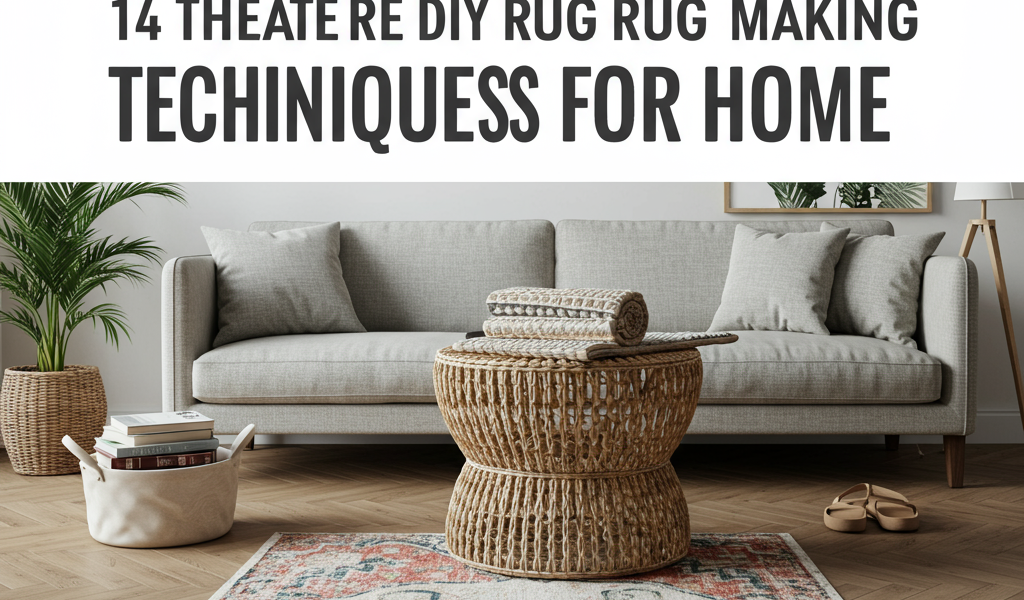14 Creative DIY Rug Making Techniques for Home
Adding a touch of personality to your home décor doesn’t have to break the bank. One of the most rewarding ways to personalize your space is by crafting your own rugs. DIY rug making offers an incredible opportunity to express your creativity while adding warmth and texture to any room. With a variety of techniques available, from simple braiding to intricate knotting, you can create custom pieces that perfectly complement your style and existing furnishings. This article explores 14 diverse DIY rug making techniques, offering a rich tapestry of inspiration for your next home project.
The Significance of 14 Creative DIY Rug Making Techniques
Crafting a rug is more than simply creating a floor covering; it’s an act of self-expression. These 14 creative DIY rug making techniques empower you to transform readily available materials into unique, functional art pieces. They allow you to control the size, color, texture, and overall design of your rug, ensuring a perfect fit for your specific needs and aesthetic preferences. This level of customization is rarely achievable with store-bought rugs, making DIY rug making a truly valuable skill.
Furthermore, the process of creating a DIY rug can be incredibly therapeutic. The repetitive motions involved in many techniques, such as braiding or knotting, can be calming and meditative. The tangible result of your efforts, a beautiful and unique rug, provides a deep sense of accomplishment and satisfaction.
Trending Now: 14 Creative DIY Rug Making Techniques
The increasing popularity of DIY projects and sustainable living has fueled a resurgence of interest in handcrafted items, including rugs. People are seeking ways to personalize their homes with unique pieces that reflect their individual style and values. This trend has propelled the exploration of diverse rug-making methods, from upcycled t-shirt rugs to intricate macrame designs. Each technique offers a unique aesthetic and allows for endless creative possibilities.
Celebrating Creativity with 14 DIY Rug Making Techniques
DIY rug making is a celebration of creativity and resourcefulness. These 14 techniques empower you to transform simple, often overlooked materials into beautiful and functional pieces of art. Whether you’re repurposing old clothes, using leftover yarn, or experimenting with natural fibers, each project is an opportunity to showcase your ingenuity and create something truly special for your home.
14 Diverse DIY Rug Making Techniques: A Comprehensive Guide
Here are 14 exciting DIY rug making techniques to inspire your next home project:
1. Braided Rug
A classic and versatile technique, braided rugs are created by intertwining strips of fabric. These can be made from old clothes, sheets, or any other suitable material.
2. Knotted Rug (using macrame cord)
Achieve intricate patterns by knotting macrame cord onto a frame or base. This technique allows for detailed designs and textured surfaces.
3. Crochet Rug
Using a crochet hook and yarn, create beautiful and textured rugs in various shapes and sizes.
4. Hooked Rug
Employ a latch hook tool to create looped pile rugs with yarn or fabric scraps on a canvas backing.
5. Woven Rug (using a loom or cardboard)
Weaving allows for complex patterns and textures, utilizing yarn or fabric strips on a loom or simple cardboard setup.
6. T-Shirt Rug
Upcycle old t-shirts into colorful and comfortable rugs by cutting them into strips and weaving or braiding them.
7. Denim Rug
Give old jeans a new life by creating a durable and stylish denim rug.
8. Pom-Pom Rug
Create a soft and playful rug by attaching numerous fluffy pom-poms to a backing.
9. Rag Rug
Use fabric scraps to create a textured and cozy rag rug.
10. Jute Rug
Work with natural jute twine to create a rustic and durable rug.
11. Rope Rug
Coil and stitch rope to create a nautical-inspired rug.
12. Fleece Rug
Create a luxuriously soft and warm rug with fleece fabric.
13. Bath Mat Rug (using pebbles or corks)
Craft a unique and textured bath mat using pebbles, corks, or other small materials.
14. Floorcloth Rug (painted canvas)
Design a custom rug by painting a canvas drop cloth with your desired pattern or design.
Facts about DIY Rug Making
DIY rug making allows for unparalleled customization and creative expression. It’s a sustainable practice, often utilizing repurposed materials. Many techniques require minimal equipment, making them accessible to beginners. Creating a DIY rug can be a meditative and rewarding experience.
Frequently Asked Questions (FAQs)
What materials do I need to make a DIY rug?
The materials required depend on the chosen technique. Common materials include fabric scraps, yarn, rope, jute, canvas, and a variety of tools like crochet hooks, weaving looms, or simply a pair of scissors.
What is the easiest DIY rug making technique for beginners?
Braiding and pom-pom rugs are generally considered the easiest techniques for beginners due to their simplicity and minimal equipment requirements.
Where can I find inspiration and tutorials for DIY rug making?
Numerous online resources, including blogs, video tutorials, and social media platforms, offer inspiration and step-by-step instructions for various DIY rug making techniques.







No Comments